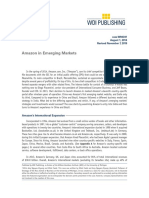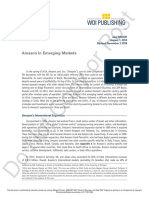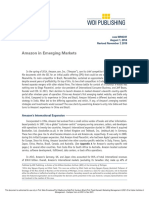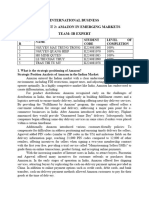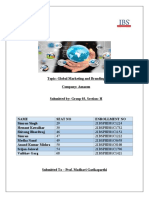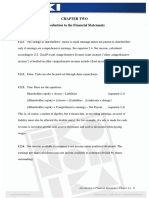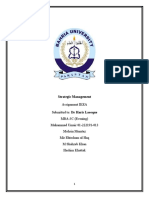Amazon in India
Unlike China, Amazon entered India quite late, in 2013, through a Greenfield mode of entry by
launching its amazon.in marketplace platform. The Indian government had liberalized its multi-
brand retail FDI policy in 2012, and the foreign firms could operate in the market but were only
allowed to have an equity stake of 49%. Hence Amazon decided to be a pure marketplace,
instead of selling its own products to avoid the ambit of multi-brand retail FDI regulations.
When Amazon entered, Indian e-commerce had three major players, Flipkart, Snapdeal, and
eBay. Flipkart was launched in 2007 by former Amazon employees and had many similarities
with Amazon’s business model. Cash-on-delivery as well as card-on-delivery were well-
established modes of payment for Flipkart. It also had developed its own logistics network
covering the entire country. It was VC-backed and planned for an IPO in the US in 2022. The
company grew its product offerings by acquiring smaller Indian e-tailers throughout 2007 till
2013. In 2014, it acquired one of the largest Indian fashion e-tailer Myntra.
Snapdeal was originally designed as a website for e-coupons in 2010. However, in 2011, it was
reoriented to follow Alibaba’s marketplace model. Drawing heavily from its investors, including
the US-based eBay, Snapdeal grew quickly and enrolled 30,000 sellers by 2014, compared to
just 3000 sellers on Flipkart. eBay had entered India in 2005 by acquiring Baazee.com but had
been extremely cautious with growth, limiting itself to selling only gift articles such as flowers
and chocolates using store partners. The company continued to operate its auctions model and
invested in Snapdeal with hopes to enter the B2C marketplace. eBay and Snapdeal partnered
with FedEx, BlueDart, and DTDC for logistics. By 2014, eBay had signed up 45,000 traders, in
addition to Snapdeal’s 30,000 traders and also offered the option of exports using eBay’s
international sites. In 2017, Flipkart acquired eBay’s India operations and also made an
unsuccessful attempt to acquire Snapdeal.
In 2014, Amazon’s revenues from the Chinese operations were falling fast and the company
had to get its India bet right. Amazon already had its software development center and back
office in Bangalore. The firm deputed its trusted MD of the Bangalore center to lead its online
retail foray in India. Under his leadership, Amazon India decided that its core strength in the
country would be in the domain of logistics and distribution. Apart from a few metro cities,
India was known for its hard-to-reach towns and villages. Even the infrastructure in the metro
cities was aging and traffic congestion was a common sight. Upon entry, Amazon invested in
large fulfillment centers on the outskirts of metro cities. It decided to use all kinds of
transportation means to reach the last mile. It started a program called “Amazon fulfilled” for
smaller retailers who would use Amazon’s fulfillment centers to store their merchandise for a
fee. Furthermore, Amazon would take care of the delivery of their products for an additional
charge. In addition, Amazon offered next-day shipping for these orders, benefitting the sellers
as well as differentiating itself from the competition. It brought in its technical expertise to
service as much area as quickly as possible. Within a year, the company could service 21,000
postal codes as compared to just 12,000 serviced by Flipkart.
1
�Even with its growing network, it was not practical to blanket the entire country. To tackle this
challenge, Amazon on-boarded several mom-and-pop stores in remote locations to become
Amazon partners. The company invested in reorganizing these smaller stores, encouraging the
owners to follow best practices in inventory management. It also invested in a computer and an
internet connection per store where customers could go online from the store and place orders
on Amazon. The store owners would receive the items, alert the customers, collect cash
payments and manage the last mile delivery, as well as returns. They would deduct a handling
fee from the collected amount and pass on the payments to Amazon. This model worked very
well for groceries as well as electronic items increasing the store owners’ revenue several fold.
On the other hand, Amazon brand penetrated even the rural India.
Being a marketplace, Amazon’s goal was to attract sellers in large numbers and was more
patient with smaller Indian sellers learning from its mistakes in China. The firm offered a
membership agreement for an annual charge of ₹ 499 to help sellers utilize Amazon’s platform,
deal with online payments as well as use the “Amazon fulfilled” option. This, in addition to a
transaction charge and commission, was still an attractive proposition for many smaller sellers.
Through other initiatives such as Amazon Tatkal, the firm helped the sellers to complete the
registration, get online and begin selling their products in a matter of sixty minutes. In addition,
the firm provided a mobile studio that would visit the sellers to photograph the products
helping them get ready to go online quickly. It provided inventory-versus-order reports showing
trends to help the sellers manage their operations and reduce holding costs. By 2015, 86% of
the registered sellers began using Amazon fulfilled service. Their revenues increased three
times, by about ₹ 10 million, as compared to previous years before associating with Amazon.
For the remaining 14%, who were larger and had fulfillment centers of their own, Amazon
offered only the logistics option under the service called EasyShip. This too was very useful to
the sellers and increased their revenue by about 40% than before.
Amazon continued to increase its Indian investment, at times investing more than its gross
revenues from the country. To attract buyers, it introduced referral programs consisting of
lucrative commissions for directing traffic to the website. For all customers, it offered free
shipping on orders above ₹ 499. The firm had instituted cash-on-delivery and card-on-delivery
ever since its early years in the country, even if it meant payment delay to Amazon by over a
week. Amazon waged a war on Flipkart by cutting prices, and by matching Flipkart’s next-day
delivery promise, and later its same-day delivery guarantee. By 2017, Amazon overtook Flipkart
in terms of market share. It also was considered the most trusted online retail brand by the
Indian customers.
Interestingly, Flipkart was registered in Singapore, and legally, was not an Indian company.
Majority of its shareholder were foreigners. As a result, Flipkart was subject to the same
regulations as Amazon and could only operate a marketplace model. To get around these
regulations, Flipkart started an Indian subsidiary with a 49% stake, called WS Retail, which
became the major seller (i.e. supplier) on the Flipkart platform. By internalizing the selling
2
�function through WS Retail, Flipkart increased its margins. Amazon too followed this model and
started a subsidiary called Cloudtail as a JV between Amazon Asia (49%) and Narayana Murthy’s
private equity firm Catamaran ventures (51%). Cloudtail soon became the major seller on
Amazon platform providing greater variety, and more control over product quality, features,
volume and price. With Cloudtail, Amazon had replicated its US business model of being a seller
as well as a marketplace for third-party products.
While Flipkart initially did not operate a warehouse model but provided logistic support after
receiving the orders, the model was unviable with growing volumes. Additionally, the increasing
cases of product returns pushed it to follow Amazon and invest in its own warehouses.
Flipkart is a smaller firm compared to Amazon and is mainly VC-backed. Additionally, it has
grown through acquisitions and maintains the acquired brands as separate entities, unlike
Amazon’s one-stop-shop. This product aggregation gives Amazon an edge over Flipkart as
customers do not need to be directed to another website for serving different product
categories. The aggregation provides economies of scale as well as bigger revenues per order.
To increase its order size, Flipkart introduced no-extra-charge EMIs for larger orders such as
appliances as well as exchange rebates for older appliances. The goal was to attract customers
who would make larger purchases on Flipkart. These innovations did increase Flipkart’s revenue
in the short term. However, Amazon quickly imitated them. In addition, Amazon launched
several innovative services on its own. For example, KiranaNow connected customers with
nearby grocery (i.e. kirana) stores with a delivery guarantee of 2 hours. It launched Project
Udaan to connect SMEs from very remote locations to Amazon platform and trained them to
help customers, handle shipments and returns. It launched AmazonBusiness.in to help small
businesses make wholesale purchases. In addition, it launched a program to increase its offline
presence, called I Have Space, whereby stores in 225 cities served as pick-up points for orders
placed online. Through Amazon Now and Amazon Pantry, the firm created a complete one-
stop-shop for the buyers. It also invested heavily in AI to make better sense of its sellers’ and
customers’ data. Its global IT team unified the India operations with the global platform.
In 2018, its rival Walmart acquired a majority stake in Flipkart for $16 billion making it the
world’s largest e-commerce deal thus far. Walmart was bullish on the Indian market and
wanted to extend its omni-channel retail strategy. Flipkart in return got a huge cash influx.
Amazon and Flipkart’s attempts to promote their own selling subsidiaries, namely Cloudtail and
WS Retail, as well as their private labels, caused uproar among the smaller sellers. In 2019, the
Indian government began investigating the two firms for possible anti-competitive practices.
Around the same time, Indian behemoth Reliance group made its plans to enter online retail
space. Being an Indian firm, Reliance could potentially operate a 100% owned multi-brand retail
channel as well as a platform. Seeing these developments, Amazon founder Jeff Bezos made an
impromptu trip to India in January 2020 to reassure the small sellers as well as the government
about Amazon’s commitment to India. While the government officials gave a cold treatment,
3
�Bezos announced fresh investment of ₹ 2500 crore in the country to digitize SMEs, strengthen
Amazon Pay as well as its data and entertainment services.
Question: Compare Amazon’s approach to the Indian market with respect to the Chinese
market.











